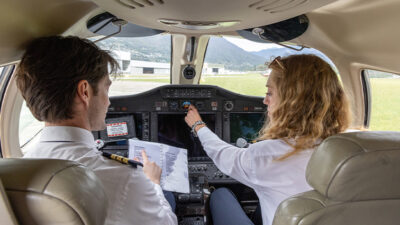To Share or Not to Share?

Modern, technology-based safety systems like SMS depend on data. Lots of data. Presumably, the more data, the better the system. If it can be gathered and measured, it can be managed.
How We Gather Safety Data
In the world of business aviation, safety data flows from three primary sources:
- Post-incident and post-accident investigations
- Outside observation
- Voluntarily submitted incident/hazard reports
Investigations take a long time, and thankfully there aren’t very many business aviation accidents. Thus, it is hard, if not impossible, to use business aviation accident data to develop proactive approaches to safety improvement. The result is almost always “tombstone safety.”
Outside observation, typically involving an audit or violation, is reasonably effective at providing short-term proactive safety improvements for the organization being observed or fined. But observations that spotlight a weakness or a required area of improvement are rarely, if ever, shared. Sometimes a flight department’s audit results are sanitized before they are shared inside a company. Too often, the audit cycle is: Prepare…Perform…Brag…Forget…Repeat.
If your team encourages voluntary reporting of incidents and hazards, you might get some reasonably good data; but if you are a small to mid-sized operation, the volume of data tends to be too low to be statistically meaningful. Identifying trends that could lead to an accident is quite challenging. The advantage of size is required to support a successful voluntary reporting system.
However, we can gain the advantage of size if we combine and share voluntary submissions of incident and hazard data across the business aviation community. We have known the potential upside of data sharing for a decade or more.
The question is why can’t we accomplish intra-organizational sharing of safety data? What is stopping us?
1. The Lack of an Industry-Wide “Just Culture”
Business aviation operators continue to punish, either directly or indirectly, those who commit human error. In an industry where reputation is paramount, the fear of admitting a mistake is understandable. If you care about your career, cover it up…What happens in the cockpit, stays in the cockpit…What happens in the flight department, stays in the flight department…The boss is never going to hear about this…If you do that one more time you are fired.
2. System Mistrust
Lack of a just culture won’t be a roadblock if submitter anonymity can be guaranteed. Pilots (and companies) can be persuaded to share data if there is no way to trace the source. But we live in a world where we find it increasingly difficult to protect our privacy. How in the world can we de-identify a hazard report to the point that it is untraceable?
3. Fatigue
The mental, physical and economic energy required to produce yet another report is difficult to envision. This is certainly true for the pilot, dispatcher or technician who must be persuaded to submit a hazard report at the end of a flight or a work shift. Flight department and company managers have so many “high priority” tasks that the additional requirement to participate in a data-sharing program by preparing a report isn’t going to be a cause for rejoicing. A monthly (or weekly) safety report requirement can easily sink to the bottom of the to-do list. Automation can help, but the process of training people to use automation creates its own energy drain. “How does this thing work again?” “I don’t know, I gave up.”
4. Money
More realistically, a lack of money is an issue. Aggregating and disseminating cross-organizational safety data requires a significant infrastructure and financial investment. Systems must be developed and tested. Speeches must be given. Committees must be formed. Meetings must be held. Newsletters must be written and mailed. A manager must be assigned and paid. Computers and software must be purchased and upgraded. Unless an overarching business aviation industry group or organization spearheads and sponsors the effort, it won’t happen. And that support must be pledged for the long-term, enthusiastically supported by upper management.
5. Getting Everybody Onboard
Cross-organizational data sharing won’t happen if flight departments are insular and protective. “We will wait and see how this thing works before we jump in.” That is the attitude that will doom a sharing program. The momentum for positive change will ultimately depend upon voluntary participation and victories.
These are the five primary challenges to successful data sharing. There are others: fear of regulation, resistance to change, jealousy, lack of an influential and charismatic leader and negativity to name a few. It will take effort and courage to create a cross-organizational Business Aviation Safety Action Program (BASAP).
Some Positive News
Across the industry there are some glimmers of hope. A few flight departments are unofficially beginning to share data with their hangar or airport neighbors. One or two regional groups—a big shout out here to the Southern California Business Aviation Association—are meeting the issue head on and attempting to develop a localized sharing system. The concept of a BASAP is starting to gain traction with safety leaders and national organizations. The FAA Aviation Safety Information Analysis and Sharing (ASIAS) system is a positive move in the right direction but its success is tied directly to participation and is our industry up to this challenge? Are we willing to make some trust-based sacrifices for the greater good? It remains to be seen.
Stay tuned and stay in touch.
For more information:
FAA Aviation Safety Information Analysis and Sharing (ASIAS)
Fact Sheet – Aviation Safety Information Analysis and Sharing Program

Customized Safety/Quality Management programs and related business solutions developed by experienced and credentialed safety professionals include training, manual management and SMS implementation/software. Based on ICAO and other international standards and regulations, Baldwin’s programs support Business Aviation, Charter, MRO, Ground Operations and Handling, FBO, Airport, Medical Transport, UAS and Regional Airlines by providing scalable/flexible software, an outstanding customer experience, and our Commitment to Excellence.
http://www.baldwinaviation.com/
© 2024 Baldwin Safety & Compliance. All Rights Reserved.
Next ArticleRelated Posts

Safety in Numbers: Trends in Aviation Accidents and Incidents
Every accident is preventable; the problem is that we don’t know how to prevent it until after the accident happens. However, what we can do as an industry is honor the anguish of each event by sharing the information, the mistakes and the outcomes to improve safety for everyone.

Is ChatGPT Ready To Analyze My SMS Portal’s Safety Reports?
While industry experts continue to design the next-gen AI-backed SMS software solution, safety managers can use ChatGPT to help them treat safety issues, audit findings and classify hazards contained in their SMS reporting.

